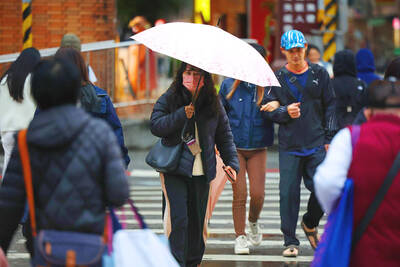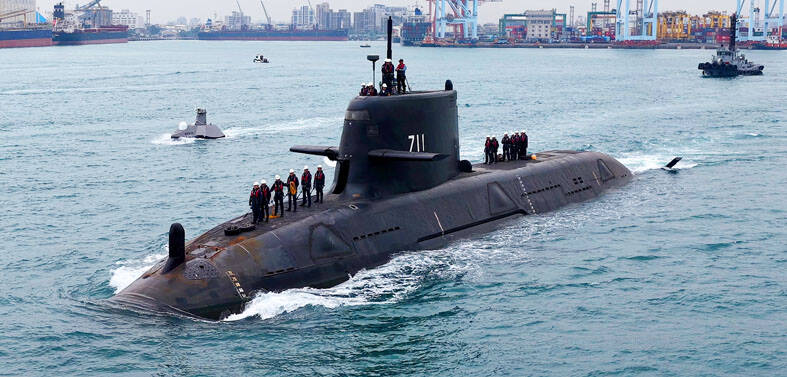The navy is planning to purchase six to eight new fighting ships over the next 10 years to replace all the Knox-class frigates it had bought from the US, defense sources said yesterday.
The navy has yet to decide on the type of ship to be purchased, but it will have to be a medium-sized ship with a displacement of 2,000 tonnes. The new ships will be heavily armed with domestically-built Hsiung Feng-II missiles.
The new purchase plan, to be called "Kuang Hua No. 7," is based on a dead project named "Kuang Hua No. 5," which dates from the early 1990s when former chief of the general staff General Hau Pei-tsun (郝柏村) asked the navy to buy the French-made Lafayette-class frigates.
Retired Vice Admiral Lan Ning-li (蘭寧利), who had been the navy's deputy chief of staff, said the change of policy has meant that the navy has been unable to build a fighting force due to its "high-low mix" of ships.
"The navy initially planned to buy a medium-sized warship from South Korea as its `low' ship, but the sudden decision to buy the Lafayette forced us to abandon the plan," Lan said.
"Later, the navy proposed the idea of buying 2,000-tonne ships again under Kuang Hua No. 5. This plan was not carried out either," he said.
The Kuang Hua No. 5 plan, a continuation of the navy's original proposal to buy medium-sized ships from South Korea, has been shelved until now.
Recently there have been strong calls from within the navy to return to the plan of buying 2,000-tonne ships, since the service has been short of this type of ship for some time. They are useful for familiarizing naval officers with the operation of an entry-level warship before they take on posts on larger fighting ships.
The ships that are to be purchased in Kuang Hua No. 7 should be a platform for the Hsiung Feng-II anti-ship missiles, and would be responsible for taking out enemy ships from beyond visual range.
A naval official, who spoke on condition of anonymity, said no decision had been taken on whether the new ships will be bought from abroad or built locally.
"Whatever the origin, these ships will replace the eight Knox-class frigates. These two types of ships are quite different in size and their combat roles. Due to a shortage of manpower, we can not afford to keep old ships while buying new ones, and we will have to remove the Knox crews to the new ships," the official said.
"The purchase of 2,000-tonne ships is part of our 10-year arms buildup plan. We expect it to succeed," he said.

NUMBERS IMBALANCE: More than 4 million Taiwanese have visited China this year, while only about half a million Chinese have visited here Beijing has yet to respond to Taiwan’s requests for negotiation over matters related to the recovery of cross-strait tourism, the Tourism Administration said yesterday. Taiwan’s tourism authority issued the statement after Chinese-language daily the China Times reported yesterday that the government’s policy of banning group tours to China does not stop Taiwanese from visiting the country. As of October, more than 4.2 million had traveled to China this year, exceeding last year. Beijing estimated the number of Taiwanese tourists in China could reach 4.5 million this year. By contrast, only 500,000 Chinese tourists are expected in Taiwan, the report said. The report

Temperatures are forecast to drop steadily as a continental cold air mass moves across Taiwan, with some areas also likely to see heavy rainfall, the Central Weather Administration (CWA) said. From today through early tomorrow, a cold air mass would keep temperatures low across central and northern Taiwan, and the eastern half of Taiwan proper, with isolated brief showers forecast along Keelung’s north coast, Taipei and New Taipei City’s mountainous areas and eastern Taiwan, it said. Lows of 11°C to 15°C are forecast in central and northern Taiwan, Yilan County, and the outlying Kinmen and Lienchiang (Matsu) counties, and 14°C to 17°C

SHIPS, TRAINS AND AUTOMOBILES: The ministry has announced changes to varied transportation industries taking effect soon, with a number of effects for passengers Beginning next month, the post office is canceling signature upon delivery and written inquiry services for international registered small packets in accordance with the new policy of the Universal Postal Union, the Ministry of Transportation and Communications said yesterday. The new policy does not apply to packets that are to be delivered to China, the ministry said. Senders of international registered small packets would receive a NT$10 rebate on postage if the packets are sent from Jan. 1 to March 31, it added. The ministry said that three other policies are also scheduled to take effect next month. International cruise ship operators

STEERING FAILURE: The first boat of its class is experiencing teething issues as it readies for acceptance by the navy, according to a recent story about rudder failure The Hai Kun (海鯤), the nation’s first locally built submarine, allegedly suffered a total failure of stern hydraulic systems during the second round of sea acceptance trials on June 26, and sailors were forced to manually operate the X-rudder to turn the submarine and return to port, news Web site Mirror Daily reported yesterday. The report said that tugboats following the Hai Kun assisted the submarine in avoiding collisions with other ships due to the X-rudder malfunctioning. At the time of the report, the submarine had completed its trials and was scheduled to begin diving and surfacing tests in shallow areas. The X-rudder,